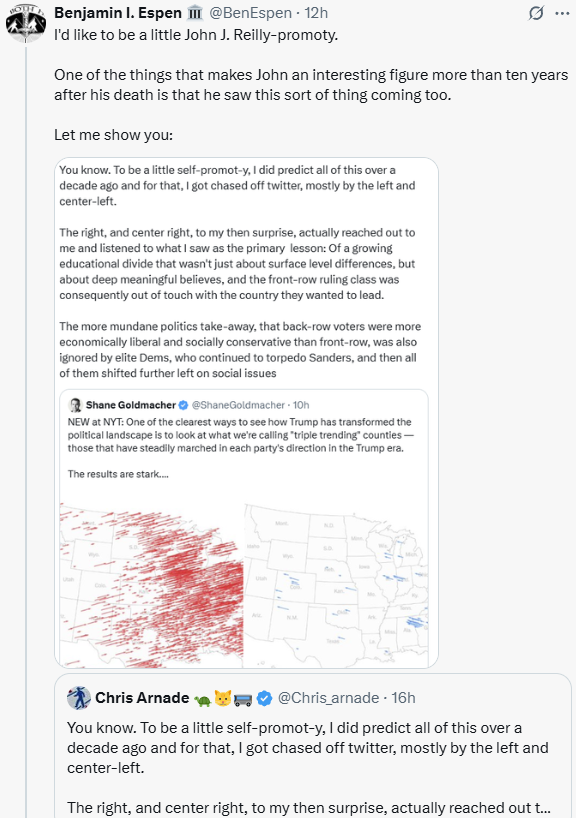The Long View: The Great Disappointment of 1844
John maintained the HTML for his website by hand. I also starting making webpages in the late nineties, and that was just how you did it. As such, he had indexes by topic for his major interests, for example eschatology. I debated recreating these for a long time, but I finally decided to do it because a few items slipped though the cracks of the blog-centric chronological method I had been using to repost John's writings.
This also gives me an opportunity to escape the tedium of John's topical political blog posts from twelve years ago. While nothing looks more dated than old scifi movies, old political controversy is an especial trial to read.
Thus, let us move on to this short book review of a book that never existed, combining John's interests in eschatology and alternative history into one!

The Great Disappointment of 1844
by John de Patmos
Misketonic University Press, 2001
567 Pages, US$30
ISBN: 0-7388-2356-2
This item is Alternative History.
The Second Coming did not actually occur in 1844.
The Great Disappointment is a real hisrorical term, however.
Look under Eschatology for the review of Arguing the Apocalypse.
The Millerite Movement and its sequel are, for obvious reasons, the most studied manifestations of mass millennialism since the New Testament period itself. Indeed, so carefully has this grand finale of America's "Second Great Awakening" been examined that one may wonder whether there is anything new for historians to say. Certainly the author of the present study does not aspire to novelty. Rather, "The Great Disappointment of 1844" performs the invaluable service of sifting through the last generation of scholarship on the subject to provide a narrative that is both readable and current.
The optimism of America in the early decades of the 19th century was reflected in the "postmillennial" view of history that underlay the great outbreak of religious revival and social reform that we know as the Second Great Awakening. Postmillennialism, as all students of eschatology know, was the doctrine that the Second Coming of Christ would occur at the end of the thousand year reign of the Saints, the Millennium foretold by Chapter 20 of the Book of Revelation. The implication was that the Saints would themselves put the world in order in preparation for the great event.
The Second Great Awakening was in fact characterized by a high level of political and cultural engagement by Christians. The reform movements of the time, from Abolitionism to Women's Suffrage to the Prohibition of Alcohol, began as aspects of postmillennial religious revival. While some progress was made on these fronts, the failure of the reform movements to remake society as a whole caused many persons to despair of the possibility that the world could be perfected purely by human efforts. The time was ripe for a return of premillennialism, the doctrine that the Second Coming would inaugurate rather than conclude the Millennial kingdom, which would then develop under divine guidance.
The name that became inextricably linked with the triumph of premillennialism was William Miller, a respectable farmer and keen amateur student of scripture living in northern New York State. His reexamination of the dating of people and events in the Bible, set alongside certain familiar interpretations of the complex prophetic number systems of Daniel, Ezekiel and Revelation, convinced him that the Second Coming would occur around the year 1843. Though his analysis was multi-layered, a key feature of his logic was a demonstration that a proper calculation of the generations mentioned in the Old Testament showed that Bishop Ussher, who had famously announced that the world had been created in 4004 BC, had in fact underestimated the age of the world by a good 150 years. Thus, the six-thousandth year of the world would occur in the first half of the 19th century. Then would begin the "Seventh Day of Creation," a concept long associated with the Millennium.
William Miller was not the first student of scripture to set a near-term date for the Parousia. Still, he was a little unusual in the transparency of his argument and his willingness to engage critics. Miller was never the "prophet" of Millerism; his authority was arithmetic, not personal revelation. It was possible to disagree with his calculations, and many people did. Still, the argument was of such a nature that it could not be merely dismissed; it had to be refuted.
William Miller reached his conclusions about the dating of the Second Coming about 1830. He soon began to disseminate them in print and, more diffidently, on speaking tours. His message took on a life of its own, becoming the template for an interdenominational network of evangelists and publications. People abandoned their ordinary affairs to propagate the gospel of the last days, often giving away their property or neglecting to plant their fields. The precise date for the great event, October 22, 1844, did not come from Miller, or indeed from any of the leading figures of the movement. Rather, it appeared among the mass of believers, who overwhelmingly gave it immediate acceptance.
Of course, as we now know, the prediction was correct. The study of the Parousia Event of 1844 naturally overshadows the Millerite Movement (as it does the contemporary Taiping and Babist movements). However, the Days of the Presence required the creation of a new historiographical discipline, which the present study only briefly outlines. The Millerite story picks up when coherent documentation again begins to become available in January of 1845.
Against the unsettled economic and cultural landscape of the early Millennial world, Millerism presents the not unfamiliar spectacle of a movement destroyed by its own success. The ironic details are well known. Even historical survey courses devote some attention to accounts of the attempts by exasperated Millerites to regain control of property that they had given away, sometimes by arguing in court that they had been temporarily insane during the months leading up to the Advent. Far more important, however, was the fact that Millerism, and premillennial Christianity in general, had nothing to say to the Millennium.
The movement had come into existence as a reaction to the theory that Christians, as Christians, had a duty to leaven the world. Premillennialists had consciously recoiled from the labor of formulating a social philosophy, or even a coherent political program. The Millerite Movement had been entirely about chronology. Though the train left at the expected time, the premillennialists found that they had no idea where they were going.
This vacuum at the heart of post-Millerite evangelicalism had profound implications for the role of religion in the English-speaking world during the 19th and 20th centuries. It is a commonplace among historians that the great events of those years, the US Civil War and the First and Second World Wars, were to a greater or lesser extent "Wars of Armageddon," fought by societies for reasons that were essentially millenarian. All the great social movements of the period were also informed by the millennialist "Social Gospel." However, though evangelicals took part as individuals in the general historical process, they did not engage the great issues on a soteriological level. It was only in the last quarter of the 20th century that they began to emerge from the isolation of the denominational subcultures into which they had retreated. The end of the long alienation of a large a fraction of Christianity can only be applauded.
We will never cease to experience the influence of the events of 1844. Even the completion of the current Sabbatical Millennium will not nullify the process that began with the Parousia of that year. However, there are stories within that greater story, some of the saddest of which deal with the disappointment occasioned by the fulfillment of prophecy. Those stories can have an ending. Thus, though the historical debates may go on, we may hope that the long afterlife of Millerism is at last drawing to a close.
Copyright © 2001 by John J. Reilly



Comments ()